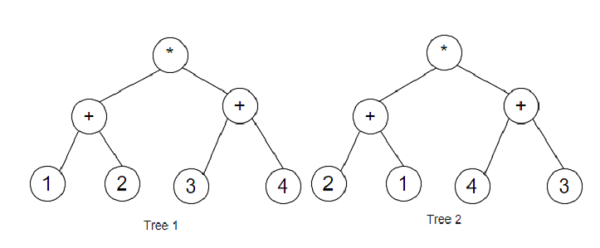
 Data Structure
Data Structure Networking
Networking RDBMS
RDBMS Operating System
Operating System Java
Java MS Excel
MS Excel iOS
iOS HTML
HTML CSS
CSS Android
Android Python
Python C Programming
C Programming C++
C++ C#
C# MongoDB
MongoDB MySQL
MySQL Javascript
Javascript PHP
PHP
- Selected Reading
- UPSC IAS Exams Notes
- Developer's Best Practices
- Questions and Answers
- Effective Resume Writing
- HR Interview Questions
- Computer Glossary
- Who is Who
Program to find out if two expression trees are equivalent using Python
Suppose, we are provided two expression trees. We have to write a program that checks the two expression trees and determines if the expression trees generate similar values. The two expression trees are provided to us in an in-order manner and we return a True value if they match, or else we return a False value.
So, if the input is like

then the output will be True.
The two expression trees evaluate to the same value.
To solve this, we will follow these steps:
-
Define a function dfs() . This will take node, dic
-
if node is empty, then
return
-
if left of node and right of node is not empty, then
dic[value of node] := dic[value of node] + 1
dfs(left of node, dic)
dfs(right of node, dic)
-
dic1 := a new map containing integer values
dic2 := a new map containing integer values
dfs(root1, dic1)
dfs(root2, dic2)
return True if dic1 is same as dic2.
Example
import collections class TreeNode: def __init__(self, val=0, left=None, right=None): self.val = val self.left = left self.right = right def insert(temp,data): que = [] que.append(temp) while (len(que)): temp = que[0] que.pop(0) if (not temp.left): if data is not None: temp.left = TreeNode(data) else: temp.left = TreeNode(0) break else: que.append(temp.left) if (not temp.right): if data is not None: temp.right = TreeNode(data) else: temp.right = TreeNode(0) break else: que.append(temp.right) def make_tree(elements): Tree = TreeNode(elements[0]) for element in elements[1:]: insert(Tree, element) return Tree def solve(root1, root2): dic1 = collections.defaultdict(int) dic2 = collections.defaultdict(int) def dfs(node, dic): if not node: return if not node.left and not node.right: dic[node.val] += 1 dfs(node.left, dic) dfs(node.right, dic) dfs(root1, dic1) dfs(root2, dic2) return dic1 == dic2 root1 = make_tree([1, '+', 2, '*', 3, '+', 4 ]) root2 = make_tree([2, '+', 1, '*', 4, '+', 3]) print(solve(root1, root2))
Input
root1 = make_tree([1, '+', 2, '*', 3, '+', 4 ]) root2 = make_tree([2, '+', 1, '*', 4, '+', 3])
Output
True

